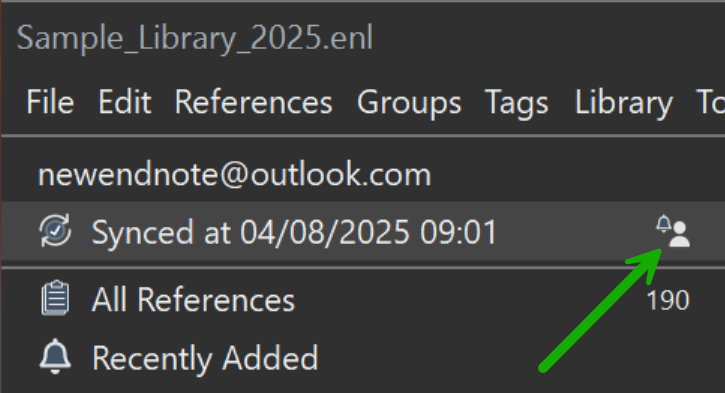The Shared Library Activity Feed
The Shared Library Activity Feed provides Shared Library members with insight into who is doing what to the shared library, as well as when new members join.
Each Shared Library comes with an Activity Feed, both the library you are sharing with others, and those libraries that others have shared with you. This feature has been available since EndNote X8.
The Feed is attached to the associated Shared Library window. You can click on the Activity Feed drop-down button, to the right of the bell icon in the Sync Status, to display it, scroll through the updates listed and click outside the feed to dismiss it.

How is the activity displayed?
Activity is presented in reverse chronological order, and the Feed will update to display all the new activity that has happened since you last synced changes to the Shared Library. Next to each sync span, you will see the sync icon with a sync timestamp and below it all the latest activity that was retrieved. The activity is displayed in this way to update you with all the latest activity since you were last working on the library.
What activity is reflected in the feed?
All Shared Library member activity including:
- Activities: Adding, modifying, moving to or restoring from Trash, deleting (emptying Trash)
- Library objects: references, attachments and figures, Groups and Groups Sets.
- New member joining the library by accepting the invitation
- When a user has performed an action more than 1 time, that activity is consolidated into one line. Example: adding 145 new references
- Exceptions are Groups (Smart, Combined, Custom) or Group Sets being created. These are listed out individually so a user can select that activity line and be taken to the Group or Group Set to display contents.
- The deletion of one or more Groups or Group Sets is consolidated to one line. The user can select that activity line and see the deleted Group or Group Set names listed out on individual lines.
- What is considered a "modification" of a Smart or Combined Group: 1) New search criteria or group being added or taken away 2) Group is renamed 3) moved to new Group Set
Which activity lines are active versus inactive?
Items listed in the feed are distinguished as active vs. inactive by the font color. Inactive lines, such as a member joining the Shared Library, are a light shade of gray, indicating to the user that they are unable to select that line.
Activity lines not in light gray are meant to signify that they will show more information. For example, selecting a line that says “Bob Smith added 145 references” will display those 145 references that Bob Smith added in a temporary Activity Feed group. Selecting a line that says “Bob Smith created a new Smart Group” will cause that Smart Group to be highlighted in the Groups pane and its reference contents to display in the library view.
What activity is not in the Shared Library Activity Feed?
Members being invited or revoked will not be reflected in the feed, it is only when a user has joined by accepting the invitation. Also excluded is activity done by the library owner in the EndNote online environment, though activity done by the owner on an iPad/iPhone will be reflected.
If the owner has shared individual groups instead of sharing the whole library, changes made by those sharing the individual groups will not be included in the activity feed.
What happens when I select a line of activity and some content has since been deleted?
If you select a line of activity to which changes have since been made (e.g. “Bob Smith added 200 references” but more recently, another member of the library, Mike Hammer, deleted 75 of those) you will be presented with the remaining references. You will be viewing the most up-to-date set of references and attachments.
Can I undo a line of activity?
No. The Feed is meant to inform and does not offer the ability for users to roll back changes or access an earlier version of the Shared Library.